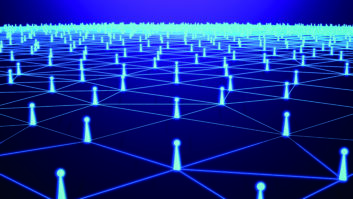(click thumbnail)Figure – 1It’s the little things that mean a lot!
Consider those solid-oak studio doors that you specified for that added soundproofing touch to the studio project. They’re great, except they lack a window.
If there’s no studio window in the wall next to the door, one might walk in on talent in the middle of a recording session. The on-air light stays constantly illuminated, because most talent will leave the microphone on, potting it up and down as needed.
So the dilemma remains: how do you know when to enter the studio? You peek!
Many years ago the engineers at Curtis Media in Raleigh, N.C., were faced with this same problem. To make matters worse, the studio door opened into a very busy newsroom. A door security peep-hole was installed at a modest cost, and the problem was eliminated.
Figure 1 shows the peep hole mounted to the lower right of the production sign. It’s hardly noticed, and the wide-angle lens brings the whole studio into view.
Thanks to the Curtis engineering staff for sharing their idea.

. . .
(click thumbnail)Figure – 2
If you’ve ever spent time crawling under a console, or even duct-taping cables at a remote, you’ll appreciate the find shared by Bonneville Washington engineers.
Home Depot offers a variety of inexpensive Velcro-attached knee pads. They fit snugly and can be removed in a jiffy. The elastic straps make them comfortable for walking upright.
Figure 2 demonstrates the protection offered both the knee and shin. The plastic knee cup is also padded, so you’ll hardly know you’re on your knees – a godsend for the seasoned engineer.

. . .
(click thumbnail)Figure – 3
Cable trays, conduit and other wire management systems can be costly. If you’re running cables on a budget, and they will be “up and out of the way,” consider the PVC solution shown in Figure 3, used by Ron Fribush at WEVA(AM) in Emporia, Va.
Needing to run several mult cables within the transmitter room, aesthetically pleasing wiring trays could have been selected. Ron used cut PVC couplings instead, saving money for needed studio upgrades. Proper spacing of the PVC couplings prevents cable droop, and the cut in the top of the coupling simplifies the process of adding cables later.

. . .
(click thumbnail)B>Figure – 4
If it takes more than a few seconds to locate a tool in your tool box, you might want to adopt the “bin” method, as Tim Parker of WWZZ(FM) in Washington, D.C., put into practice.
As shown in Figure 4, each drawer of the tool chest uses the cardboard “parts” bins to separate like tools. The cardboard prevents marring of the chest drawer, and speeds selection of a specific tool.

. . .
A Workbench reader has a customer looking for a bit to drive ground rods using a jackhammer.
John Stortz, drove multiple 10-foot (or longer) ground rods around his tower site, using a stepladder and sledge hammer. The rods were steadied by a couple of trusting hands as John drove them into the ground.
I’ve never heard of a bit that would fit a jackhammer, but thought I’d query the readers of this column.
I suggested that he check with the local power company or cellular companies; both use ground rods extensively. Any other ideas? E-mail them to me at [email protected]
. . .
Bob Seaberg is a CPBE from Illinois. He remarked about the “overloaded” tower shown in the Nov. 22, 2000, Workbench.
To save you the time looking through your archived pile of RW, this was the tower with so many coax cables that the red and white paint was obscured, and the base of the tower looked like an octopus with at least 18 coaxial cables snaking up the tower.
Bob asked if the coax runs just “grew” over the years. Actually, the runs were planned, but no thought was given to the lines obliterating the tower paint.
Bob brought up a good point that everyone who manages towers should consider: icing. There is a reason structural studies are needed before loading up a tower. Ice on antennas is one thing, but when ice coats 18 transmission lines, that’s another story.
In our subject tower’s case, the proper structural studies were performed, and though the tower cannot handle any more load, it’s not overloaded.
Keep overloading in mind if you need to spec a new tower. It’s a good idea to consider the potential for rental use, and purchase the tower with that in mind. Tim Ryan at Central Tower tells us that beefing up a tower to handle one level of PCS antennas adds a raw cost of about $2,500 to the cost of a guyed 500-foot tower.
Once the tower is in place, a structural study alone could cost this much, before any cost of strengthening the tower is considered. In the context of a tower project, adequate rental space is a minor expense, and can provide a healthy payback over time.
Submissions for this column are encouraged, and qualify for SBE recertification credit. Fax your submission to (703) 323-8044, or send e-mail to[email protected]












